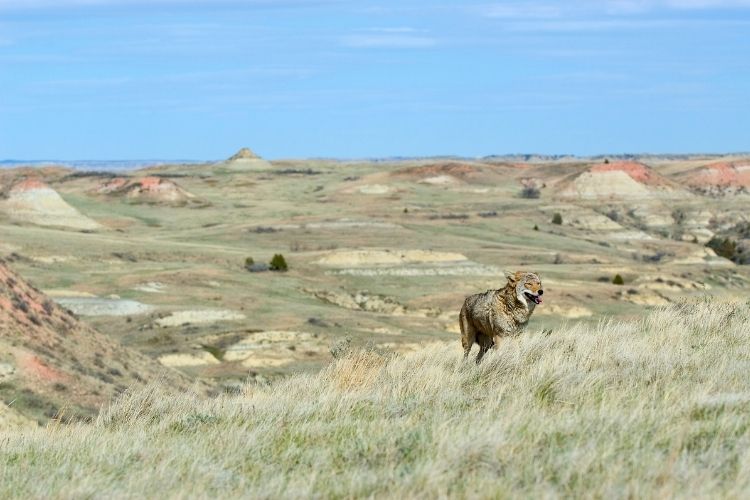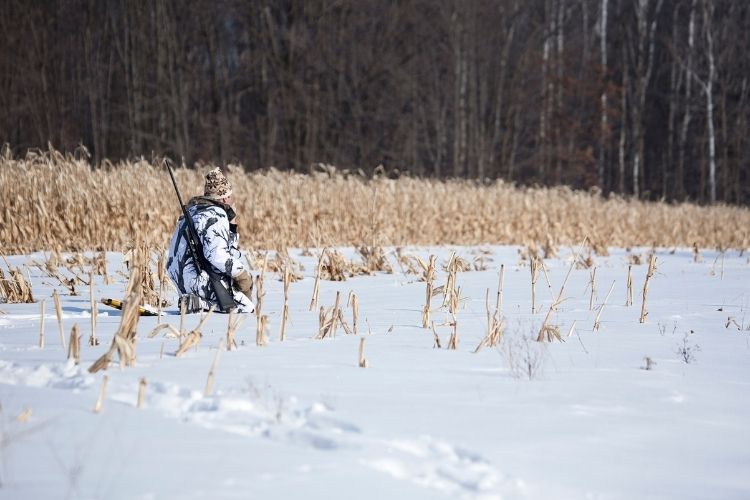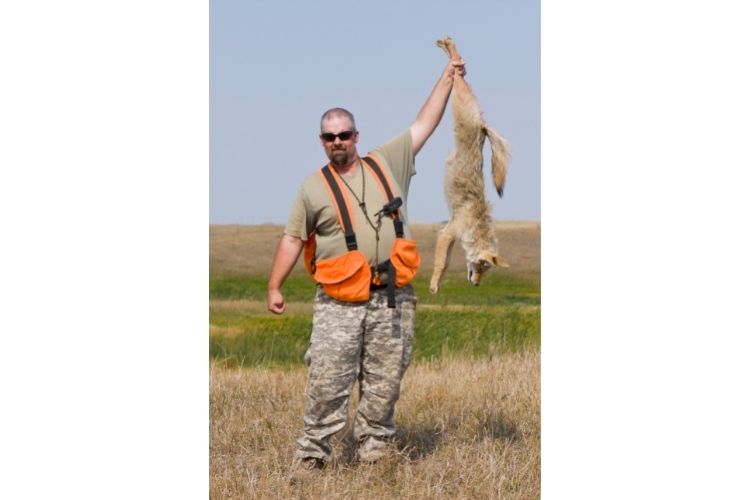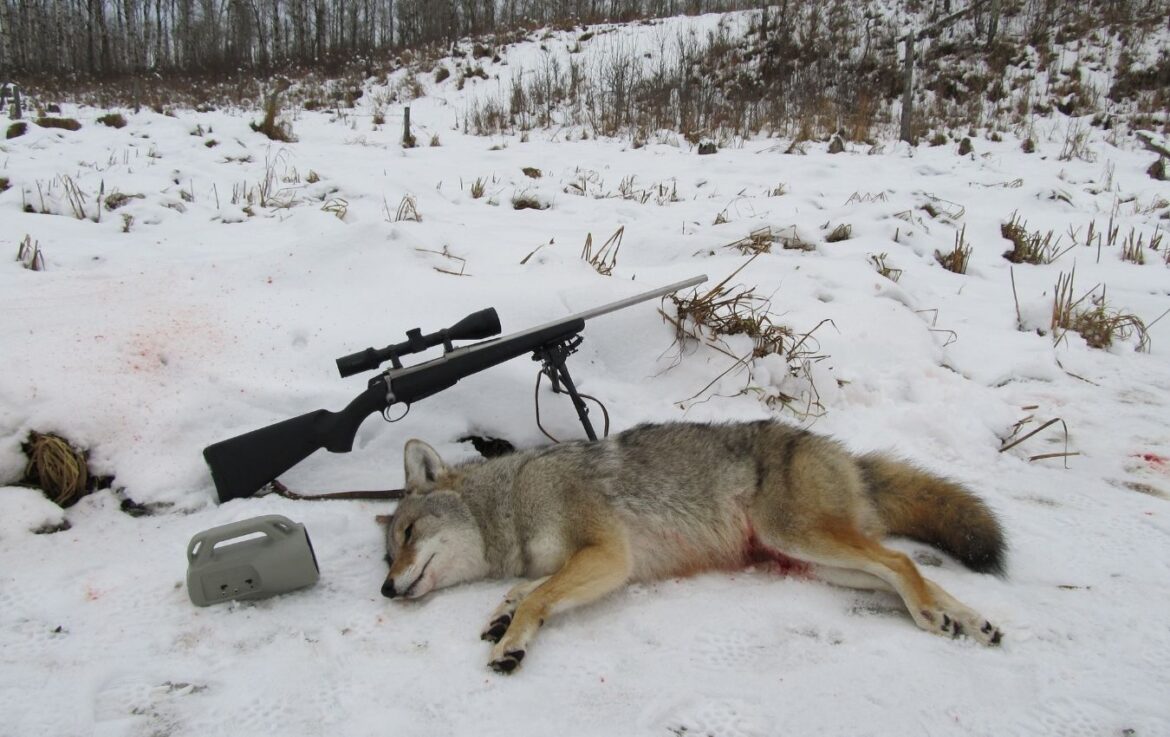Table of Contents
In need of a breath, I stopped forcing air through my vintage, hand-me-down predator call and scanned the snow-blanketed plain for signs of movement. My breathing barely had time to normalize before the sight of a moving speck in the distance returned me to the brink of hyperventilation.
A coyote had triangulated my position from more than a half-mile away and was moving toward me like an ant marching across a sprawling white picnic blanket.
Back then, I knew enough about hunting to sit still, but the approaching coyote strained my composure. By the time the coyote breached the 100-yard barrier, my heart was thumping a drumroll.
When it paused to sniff some sagebrush, I planted the riflescope’s reticle on its chest and kicked off my coyote-hunting career. It was the first coyote I had called in, and I felt an immediate sense of accomplishment. Seventeen years later, coyote hunting still causes my heart to race.
If you feel the same way, you probably already know a lot about coyote hunting. Just in case you missed a few things, however, let’s review the basics.
1. Finding Coyotes

Locating coyotes is seldom difficult. As the numbers of their natural enemies, such as wolves and bears, have diminished, coyote populations have flourished, expanding far beyond their traditional Western homeland.
Today, coyotes inhabit all corners of North America, and most proclaim their territorial dominion by vocalizing at dawn and dusk. A drive through the country in the early morning or evening can reveal the location of various packs. Every mile or so, stop, shut off your truck’s engine and listen. If you hear a howl, note the general location on a map and move on.
Stay on the roads that border overgrown terrain, which coyotes prefer for security. Coyotes take up residence in thick woods, rugged bluffs, and steep canyons. They gravitate to grassy depressions, eroded gullies, cattail sloughs, and large, brushy hedgerows for cover in the open country.
If the coyotes in your area are the silent type, trigger their howling instinct by blowing an ambulance-style siren or air horn at dawn and dusk. Assuming your coyote vocalizations are reasonably realistic, toss in a few howls of your own. An electronic call can also help. Young-of-the-year coyotes seldom can resist the temptation to answer a cousin.
Don’t be surprised if pressured coyotes refuse to shout back, however.
A recent paper published by the University of California, Berkeley, reveals that “alpha,” or dominant, coyotes won’t reply. They leave the yapping to the younger crowd.
If you don’t hear any coyotes, look for visual clues such as muddy prints along road rights-of-way or next to waterways. A fresh snow also reveals coyote tracks.
Backtracking a trail-whether snowy or muddy-can lead to coyote bedding areas. If scouting time is limited, ask people in the neighborhood if they have seen coyotes. Farmers, ranchers, bus drivers, and rural mail carriers cruise back roads regularly and frequently spot wildlife. Don’t be surprised if most landowners will invite you to visit their private land and let you take a few coyotes home with you when you leave.
2. Making an Entrance
It’s difficult to sneak up on a coyote or anywhere near one. Coyotes combine their senses and instincts to create a nearly impenetrable security system. To get within shooting range, take advantage of wind direction, approach stealthily, and camouflage yourself from head to toe.
Always enter an area with the wind in your face. There won’t be anything to hunt at your destination if you don’t. Stay out of sight, or at least maintain a low profile.
The best coyote hunters use land features to hide themselves as they travel to their calling sites. Hills, gullies, creekbeds, and trees provide cover. Travel to and from a stand in the dark if it’s feasible. Leave your flashlight in your pocket to be turned on only in case of an emergency.
Most coyote setups are at an elevated spot, but a hunter still needs to keep away from the skyline. If the hill is not too tall, circle around the sides to avoid skylining; if the hill is large, you have to go over the top, hunch over, and move quickly into position below the horizon.
On open terrain, press against a fence or brush pile. Coyotes are more likely to pick up motion from a corner of their vision, so stay low and still from time to time.
In areas with thick vegetation, push through the brush on your belly. Remain hidden by keeping your arms next to you and moving slow. Like most other wild game, Coyotes do not look down; they look forward or straight up.
3. Setting Up

Why an elevated vantage point with good visibility? Coyotes are sneaky, especially when stalking prey. If you don’t have a good view of your surroundings, you’re liable to miss a coyote’s approach.
They’re masters of keeping out of sight by entering and exiting areas along depressions and lowlands. Hilltops, ridges, and mountainsides offer stadium-style views. If you hunt flatlands, perch in a tree stand, or make use of what’s available, whether it’s a haystack, a barn loft, or junked farm equipment.
One morning a buddy and I set up high on a prairie hill where we could see for a few miles. Prairie grass and gently rolling hills provided the only cover. Three minutes into our calling, a coyote charged out of a small crease in the prairie and sped in our direction.
My partner rolled the coyote at 20 feet. Even in that wide-open environment, we would have failed to spot the coyote before it detected us without an elevated setup.
Every setup should have you facing into the wind. However, nearly every incoming coyote will attempt to circle downwind of the apparent victim it hears. It often pays to hunt with a partner who can watch the downwind side for sneaky incomers.
The calling location should be at least 200 yards from your vehicle or any place you plan to travel during the hunt. Curious coyotes may pop out of nowhere, but most travel some distance before they respond to prey distress.
4. Choosing a Call
Don’t get hung up on brand names. Your first priority is to obtain a call that you can use effectively to mimic the sounds made by creatures that are on the menu of local coyotes.
Most sporting-goods stores have plenty of rabbit-in-distress calls. Since coyotes regularly dine on bunnies, a dying rabbit call should be in your repertoire, as they are an easy meal for them. Just remember that it doesn’t take long for a coyote that’s survived a few encounters with hunters to determine that screaming rabbits also suggest hidden humans.
To outwit experienced coyotes, vary your distress sounds. Coyotes eat just about anything that moves and responds to a variety of sounds made by what they think are injured critters. Be prepared to start calling the sounds made by rodents, woodpeckers, and fawns. To further the deceit, add in the raucous call of crows.
Animal noises are best duplicated with diaphragm calls or electronic calls. A mouth call can do the job, but hands-free allows you to control the volume and intensity of your sound while scanning for the game.
Try mastering the language of the coyote to provide another realistic dimension to your setup. Coyotes have a wide range of howls, barks, yips, and whines. Steer clear of barks, which represent a warning, and focus on non-aggressive welcoming howls.
A drawn-out howl tells other coyotes, “I’m here,” and challenges them into an appearance as they look for the intruder who’s invaded their turf. Smart coyotes will stay away, but bolder ones will come in to investigate.
Begin and end prey-in-distress setups with howls, or use howls by themselves to attract coyotes. How long do you wait? At a minimum, keep still for 15 minutes. I always stay at a site for at least 30 minutes; most of the coyotes I’ve shot showed up later than that.
- DEAD SERIOUS – The GC320 Electronic Predator Game Call and Decoy Combo is lightweight, compact, and easy to operate. For superior predator attraction, this product combines a visible motion decoy with audible sound effects for extreme results.
- GC320 GAME CALL – The GC320 Game Call offers an outstanding remote technology. It comes with 24 proven-deadly pre-programmed calls, allows you to play two calls simultaneously, and includes an auxiliary jack for extreme volume requirements.
- ICOTEC PD400 DECOY – The ICOtec PD400 Predator comes with LED night lights for topper illumination, speed dial control, auto-run capability, intermittent motion modes, and more. Its motor is quiet and doesn’t produce gear noise. It attaches seamlessly to the GC230 to provide complete predator attraction in a compact and easily transportable package.
- INCLUDES REMOTE – Take advantage of our 300-yard remote range that doesn’t require line-of-sight to stay better hidden from your game. This remote operates both the decoy and the game call, giving you complete mobile control right at your fingertips.
- PRODUCT SPECIFICATIONS – Package includes (1) ICOtec GC350 - Programmable Remote Electronic Predator Game Call and (1) ICOtec PD400 Predator Decoy. Decoy and Game Call each require 4 AA batteries (not included). Remote comes standard with a 12 volt battery (included). Includes 1 year factory warranty.
5. Taking the Shot
The approach of an incoming coyote can be every bit as unnerving as seeing a buck with a big rack move toward you. Success depends on a number of things that you should have already dealt with. First, be sure to camouflage everything, including your movement.
Once the calling starts, move only when necessary and at a sloth’s pace. Since coyotes rarely run straight toward your rifle barrel, you’ll need to make slight aiming adjustments before you shoot.
When it’s necessary to move the rifle, do so when natural cover such as hills, grass, or trees obstruct the coyote’s vision. If the coyote is crossing open country without obstructions, move slowly while the animal is trotting. Instead of making a bold move immediately before shooting, adjust slowly as the coyote edges closer. A close coyote will likely see any major movement and kick in its afterburners in an attempt to escape.
Unless you’ve perfected shooting at pint-sized, running targets, shoot only at standing coyotes. It’s easy to stop an incoming coyote. Keeping your reticle on the coyote, bark sharply like the neighbor’s mutt and squeeze the trigger as the coyote looks for the interloper.
Hunting coyotes tips & tricks
- Be prepared – coyotes are most active at dawn and dusk but can be seen any time of the day. Coyotes have a keen sense of smell – make sure to use scent eliminators whenever possible.
- Choose your call – choose distress calls that mimic those made by animals that you know can kill. A rabbit in distress call will work well, as will the sound of a fawn bleating for its mother. Also, consider howls and yips as these sounds may entice other coyotes into your area.
- Use surrounding natural elements to hide yourself – hills or even cattle help hide hunters from potential prey.
- Be careful not to move too quickly when there is no cover available – moving too quickly will spook prey before you can get off a shot.
- Bring friends – coyotes are usually quite social. Bringing along other hunters may increase your chances of shooting one later in the day.
- Keep it quiet – your voice and gunshots can scare away noise shy prey like coyotes
- Be patient – wait at least 30 minutes before leaving an area – it takes time for coyotes to show up.
- Don’t give up too soon – sometimes coyotes are seen shortly after setup but don’t approach until hours later
- Decoying with another hunter who is carrying a firearm works extremely well when calling for coyotes – The other hunter acts as a deterrent to the coyote while your other team members can move into another location.
Conclusion
Coyote hunting, like turkey hunting, fascinates a lot of hunters from the start. It’s challenging because you have to develop specific skills to be consistently successful.
The action can be excitingly fast if you’re in prime coyote country. If you’re hooked the first time a coyote shuffles into rifle range, embrace the addiction. And welcome to the club.

Frequently Asked Questions
What is the best time to hunt coyotes?
Coyote hunting is an all-season sport, and good results can be had, regardless of the season. The best time to hunt coyotes is when there is an available food source such as rabbits, deer, or other animals that coyotes feed on. Coyotes will follow their prey into suburban areas looking for a meal, and this makes them more visible to hunters during the day.
In the winter, coyotes will take advantage of rabbits and other easier to find species due to less vegetation. Coyotes are always on the prowl for rabbits, mice, and other rodents that can be found year-round.
What is the point of coyote hunting?
Coyote hunting is done for many reasons. Some hunters enjoy the challenge of calling in an animal that can be very difficult to hunt, especially if they are using conventional methods. Other hunters practice coyote calling to hone their skills before deer season begins.
How much does a coyote hunt cost?
The cost of a coyote hunt depends on many factors. Some outfitters have fixed price packages while others charge by the animal. The average cost is around $200-$300 per person for a day out in the field hunting coyotes.
What are some tips for calling in coyotes?
Coyote hunting presents many challenges to hunters, especially if you are new to it or are using conventional hunting equipment to call them in with. To increase your chances of success, try using mouth calls and predator decoys when possible to lure animals closer to your position. Predator scents can also be very effective at luring coyotes into shooting range.
What gear do you need for coyote hunting?
When coyote hunting, having the right equipment is imperative to be successful. Some of the important items to bring with you out in the field are camouflage clothing, scent-free soap and shampoo, binoculars, rangefinder, rifle or shotgun for shooting coyotes, predator calls, shell holders, and an ATV or UTV to get around quickly in case you need to pursue a fleeing animal.
Do you get paid to hunt coyotes?
No, there is no financial compensation for coyote hunting. Hunting coyotes is strictly done as a pastime or to hone your predator calling skills before deer season begins.
Can you attract other wildlife while coyote hunting?
If you are using predator calls or decoys to try and attract coyotes, it is possible that other predators may show up to investigate the sounds of prey. Some of the most common animals seen while coyote hunting are bears, bobcats, foxes, and sometimes even mountain lions.
Can a pup distress call bring in large predators?
Distress calls are intended to mimic an animal that is being attacked by a predator, including the sounds of loud animals like bear cubs. Many hunters believe using pup distress calls will bring in an adult bear much faster than other types of distress calls. Still, you may even attract several different animals at once, depending on where you’re hunting.
When is the breeding season?
Coyote mating season occurs during late winter and continues through late spring. Although this is a time when coyotes are most likely to breed, they can also mate at other times, depending on the availability of food sources.
Can coyote hunters use remote control coyote decoys?
Yes, coyote hunters can use remote control decoys. These coyote decoy robots have been used by U.S. military forces in Afghanistan and Iraq to mimic real animals in an effort to lure enemy combatants into a trap.
Do coyotes hunt big game or only small game?
Coyotes will hunt anything they can catch, including deer and livestock. In recent decades, attacks on humans have become more prevalent in the U.S. as coyote populations grow larger in urban areas due to a lack of natural predators and an abundance of food sources. Coyotes have gotten so used to being around humans that their behavior has become more aggressive.
Can you use a deer rifle for predator hunting?
Yes, hunters can use a deer rifle for predator hunting. The .22 caliber is the best size bullet to bring with you in case it becomes necessary to shoot an animal that is far away.
Can predator hunt be done on public land?
It is possible to coyote hunt on public land, but check with state and local laws before you head out. Some private landowners who are okay with it may also allow you to use their property for predator hunting.
Can you go hunting coyotes at night?
Yes, coyote hunting can be done at night. They are primarily nocturnal animals that hunt and forage under cover of darkness since they have poor eyesight. Predators also tend to be more active in cooler weather, making it possible to hunt them year-round depending on where you live.


